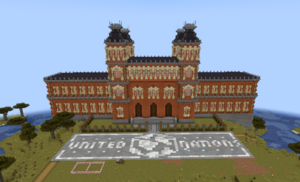Kêji architecture: Difference between revisions
Jump to navigation
Jump to search
CMCollective (talk | contribs) m alphabetises every ŋation, added Drebzha station in East Pua -Iris |
|||
| Line 20: | Line 20: | ||
==Major Kêji and Kêji-influenced works, by country== | ==Major Kêji and Kêji-influenced works, by country== | ||
=== | ===Enkavak=== | ||
* [[Gyorà Stoneworks]], company in [[Alnangaemak]] | |||
===East Pua=== | |||
* [[Drebzha]] Station, a [[Cenrail]] station built in the days of the [[City State of Amuj]] | |||
===Kingdom of Kyaw Cen=== | ===Kingdom of Kyaw Cen=== | ||
| Line 26: | Line 30: | ||
* [[Palace of the Ŋations]], headquarters of the United Ŋations | * [[Palace of the Ŋations]], headquarters of the United Ŋations | ||
=== | ===Kozdenen=== | ||
Revision as of 05:55, 25 November 2024
Kêji architecture is a decorative style of architecture, first developed in Kozdenen by Doge Peleṽa Thoa-Saevakki. Since its inception, the style has spread to other ŋations, either through Peleṽa's direct involvement in construction or from more subtle borrowings and influences.
Etymology
The term Kêji is a borrowing from Kyawcenni kêji [keːdʒi], meaning "Koz", either as a proper noun or as an adjective. This in turn is borrowed from the Kozramva endonym Keezhʉ [kø̞:ʐɨ] with the same meaning.
History
Kêji architecture can trace its roots to the first permanent structures in Kozdenen. [more info goes here]

Characteristics
Although individual buildings vary in terms of which specific traits they exhibit, the following features are characteristic of the Kêji style:
- relatively large in scale
- regular, repeating patterns in wall design and shape
- exterior walls of varying depth, typically consisting of a structural inner layer and a decorative outer layer
- extensive texturing in wall materials, with two-block textures being most common
- mansard rooves, typically constructed from blackstone with cobbled deepslate corners and typically with a border of stone bricks and iron bars
- prolific use of stair blocks within walls to emulate rustication
- oxidised copper dividers separating upper and lower sections, or similar use of cornices
Major Kêji and Kêji-influenced works, by country
Enkavak
- Gyorà Stoneworks, company in Alnangaemak
East Pua
- Drebzha Station, a Cenrail station built in the days of the City State of Amuj
Kingdom of Kyaw Cen

- Palace of the Ŋations, headquarters of the United Ŋations